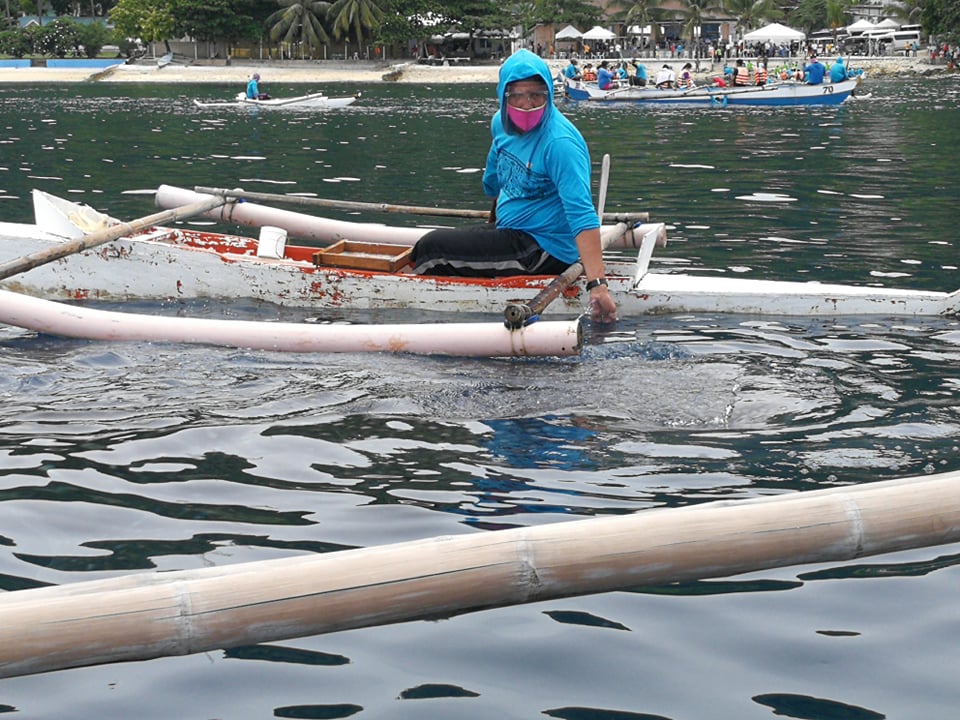
A local boatman in Barangay Tan-awan, Oslob town southern Cebu feeds a whale shark (butanding or tuki in Cebuano) during the ceremonial reopening of Cebu’s tourism industry on Friday, July 31, 2020. CDN Digital photo | Morexette Marie B. Erram
CEBU CITY, Philippines — Despite that Oslob has already opened its gates to tourism, it may still be long before the development translate to being food on the tables of the families who depend on the industry for their livelihood.
From a daily average of 1,000 visitors–mostly foreign tourists–for the renowned whale shark-watching activity prior to the pandemic, the number of tourists visiting the town since its relaunch only averages at 10 per day.
Oslob’s whale shark watching activity was the first tourism activity that Cebu province launched last July 31, 2020, in a bid to revive the province’s economy which was heavily anchored on tourism.
The tourism industry is among the sectors worst hit by the consequences of the lockdown due to the threats of the coronavirus disease (COVID-19).
READ: Oslob’s whale watching to lead reopening of Cebu’s tourism industry
READ: IN PHOTOS: Oslob’s whale shark watching under the ‘new normal’
“Naa may mangabot pero dili kaayo daghan. Actually, katong pirmero nato nga kuan mo-average lang og mga napulo tingali. Gahapon, 14 ra man gyud ang diha,” Oslob Mayor Jose Tumulak Jr. said in an interview with CDN Digital on Monday, August 17, 2020.
(There are some visitors, but not so many still. Actually, the number of visitors initially average at only 10. Yesterday, there were 14.)
“So, gakamang pa gyud ta pero at least, maayo na lang kay giablihan na,” Tumulak added.
(We are still struggling but at least the activities are now open.)
The whale shark watching in Oslob’s Barangay Tan-awan, which contributed P182 million to the town’s income for 2019, benefits hundreds of locals who engage in tourism operations. This includes close to 300 boatmen who carry the tourists to the whale shark watching site, those who are employed in accommodation and food establishments, and those who sell souvenir items, among others.
In the relaunch of the tourism industry under the new normal, the province has centralized all the tourism activities under one online portal.
Read: Capitol to develop online portal as it opens tourism industry
Read: Cebu’s tourism portal up and running
The fees for each tourism offering are directly remitted to the host local government unit (LGU) through money remittance. The LGU, in turn, is tasked to divide the income among the tourism players.
With a fee of P1,000 per tourist availing of the whale shark watching package and the average of 10 daily visitors, the tourism activity has earned only about P140,000 from August 1 to 16.
Of the amount, 60 percent will be divided among the boatmen while the 40 percent goes to the host barangay (10 percent) and the municipal government of Oslob (30 percent). Prior to the pandemic, the boatmen used to divide their shares every week.
“Karon kay dili man kaayo daghan [ang turista], patubo-tuboon sa kay kung magbahin pod unya tag-usa ka gatos ra unya ang bahin, unsaon man na,” Tumulak said.
The opening of the tourism industry in Cebu province, which is now under the modified general community quarantine, is still limited with tourists coming from Cebu province.
Governor Gwendolyn Garcia earlier said that Cebu, even without catering to foreign tourists or those coming from other parts of the country, still has a sizable tourist market, considering that the province stands with a population of over 3 million. /bmjo